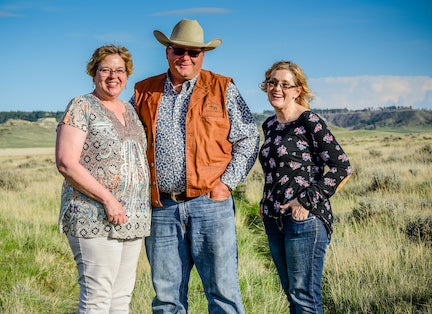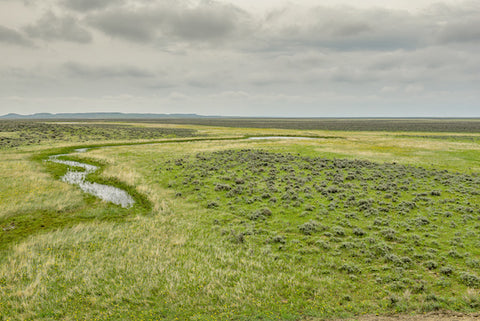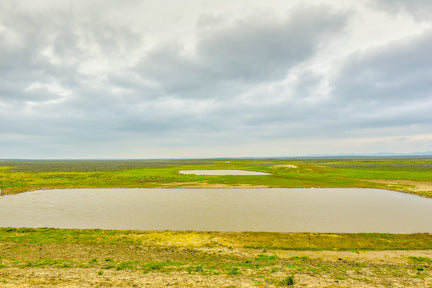Ranching and Sage Grouse
Bird and the herd: Ranchers find ways to co-habitate with rare sage grouse
BY JOHN GRASSY — In the spring of 2012, Bret Lesh was trying to figure out water and irrigation on the new 9,000-acre unit of his Cross W Ranch in Montana.
Along with every other rancher in Carter County, Montana, Lesh was subject to the yearly calculus of snow, rain, temperature, wind. In a good year, his native rangeland in spring released its bounty of western wheatgrass, blue grama, thick-spike wheatgrass, forbs and buffalo grass — a carpet of bright green amidst the blue-gray sagebrush. Snowmelt and rain filled the small reservoirs and the excavated pits that served as water sources for his cows. Sage-grouse assembled on their ancestral breeding grounds, where the males strut and joust for the attentions of nonchalant females.
But that was a good year, which was maybe three years out of five. Lesh needed to figure out water on his new property because a successful rancher in southern Carter County never loses sight of what can happen to his land and livelihood during the other two years.
When he stopped into the USDA Natural Resource Conservation Service office in Ekalaka that spring, Lesh had no doubt heard the talk around Carter County about the greater sage-grouse. The big prairie birds that held dramatic courtship rites and flushed in coveys – the mottled grayish-brown- and-white birds everyone in Carter County saw most any normal day and scarcely considered, except when they fed along the roads and posed a threat to collide with passing vehicles – were declining across much of their historic range. Wildlife biologists were in southern Carter County studying the birds. State and federal agencies were huddling to discuss conservation strategies.

Kim Lesh, left, Bret Lesh and Rebecca Knapp. Photo by Eliza Wiley
It was entirely possible in 2012 that the Greater Sage-Grouse could be listed as a federally threatened or endangered species. The sage-grouse scientists had given southern Carter County a new name: Core Area 13. “Core” referred to the relative quality and importance of the habitat for Sage-Grouse in Montana; it meant the healthiest, most intact habitat, with a stable population of birds.

Sage grouse mating. Photo by Nappadol Paothong
Rebecca Knapp, the NRCS district conservationist in Ekalaka, welcomed Lesh into her office for their meeting. In response to the growing concern over sage grouse, her agency a year earlier had launched the National Sage Grouse Initiative, a cost-share program for private landowners who committed to making improvements on their land or changes in their management regimes to benefit sage grouse, an umbrella species for 350 other sagebrush-dependent birds, mammals and other wildlife.

Rebecca Knapp Natural Resource Conservation Service (NRCS), District Conservationist, Ekalaka, MT, Carter County. Photo by Eliza Wiley
In Carter County, Knapp says, agency staff and local leaders had decided on a low-key approach to the initiative. Sage-grouse were plentiful, which meant they were successfully coexisting with local ranching practices. The talk of a federal listing for the bird already had some landowners worried. “We decided to proceed slowly and limit local publicity,” Knapp says. “We wanted to see how it went in some other areas first.”
The water problem Bret Lesh hoped to solve was as old as the history of ranching in southern Carter County, where a dependable source of clean, healthful water is hard to come by for people and livestock. The county sits atop the Pierre Shale geologic formation, which contains water of poor quality and limited quantity.
Beneath the Pierre Shale there’s ample water of good quality in the Lakota formation, but a well has to go 1,700 to 3,000 feet to reach it. Early ranchers found a solution in digging shallow pits to capture snowmelt and rain for their animals. “It’s not as easy as it sounds,” Knapp says of the practice. “You have to find the right type of soil and you need a drainage that’s large enough to supply each pit.” With several pits developed across his property, a rancher could usually acquire enough water to get his herd through the summer.
Ranchers in the county still make use of pits today, but a fundamental drawback remains: the water supply dictates where and when cows can graze. “If you rely on water from reservoirs or pits, you have to utilize that water when it’s there,” Bret says. “If they fill, you’re alright until early fall – most of the time.”

And when it’s a bad year, one of those two years out of five – when spring rain is scarce and it’s 94 degrees for five days in a row in late May with the wind blowing, and the pits and reservoirs become mudholes – that is when a rancher in southern Carter County may end up with only one water source to get him through until fall.
He’ll move his cows into the pasture adjoining that water source. The herd gets to work eating the grass, then eats it some more. Three miles away he may have a pasture loaded with grass, but he can’t put his cows there because the water supply has dried up. So the cows stay in the pasture with water.

A rectangle stock tank on Bret Lesh's ranch in Carter County, Montana. Photo by Eliza Wiley
The grasses become weak from repeated grazing, their root systems lose vigor, and the stage is set for soil erosion. After that, it may take just one major rain event to get the process started. Even if there’s no erosion, the grasses in that pasture will be hard-pressed to survive, and won’t produce as much forage the following year. Scattered across Carter County, with its erodible, clay-based soils, are the scars of erosion that started this way. Most of the damage is historic, meaning it occurred 70 to 100 years ago, but Knapp says there’s recent damage too.
In a climate that receives 14 inches of precipitation per year, returning damaged rangeland to full health can take 20 years. Bret Lesh knew all about this process. There were some badly eroded areas on his new ranch unit and he didn’t want history to repeat itself. “Bret had all this grass and very little opportunity to use it efficiently,” says Knapp. “Maybe he could run twice as many cows if he had the water and the ability to manage where they were grazing. He was pretty frustrated.” Bret described for Rebecca a possible solution for his water problem. He wanted to use one of the existing shallow wells as the water source for a network of pipelines and stock tanks.
The tanks would be deployed across the 9,000-acre property such that every pasture had its own source of fresh water. With these improvements, he could escape his dependency on seasonal water; with additional cross- fencing, he could rotate his herd through different pastures, controlling the timing and duration of grazing. Once he had the system fine-tuned, he might even be able to rest an entire pasture or two until the following year. The NRCS offered a cost-share program called EQIP, which stands for Environmental Quality Incentives Program.
Lesh was familiar with EQIP and asked Knapp about it. At that time, Carter County already had a sizable number of EQIP applications in the works and Knapp understood his chances of getting funded wouldn’t be very good. Instead, she decided to discuss the program no one had yet discussed. “I mentioned that there was a national initiative focused around sage-grouse conservation,” she says. “I asked if he might be interested in having his application evaluated in the Sage-Grouse Initiative funding pool. And to my surprise, he agreed.” The rancher saw an opportunity to improve his cattle operation; the conservationist saw an opportunity to secure and improve prime sage-grouse habitat on private land, where 64 percent of all sage-grouse live in Montana.

Sage grouse hens grazing alongside a bull at an Oregon ranch. Photo courtesy of the USDA NRCS
Bret made application for the cost-share agreement. Soon after, Knapp and her team went to work on a field assessment of his property. ii It turns out that one of the time-honored formulas for surviving as a rancher in Carter County happens to be equally beneficial for the life cycle of sage-grouse. It’s an unscientific rule of thumb for stewardship of the native rangeland and insurance against bad years: take half, leave half. Walk through a section of Bret Lesh’s rangeland in mid-May, when the new grass is coming up, and the bright green growth is obscured by a foot-high cover of residual grass.

Biologist Melissa Foster. Photo by Eliza Wiley
STRIKING A BALANCE
Most producers value sagebrush for the cover and winter feed it provides and for the diversity it adds to the landscape, but they want to see a balance of sagebrush and grass. In some areas, sagebrush reaches a density that negatively impacts the understory of grasses and forbs.
The species here is Wyoming Big Sagebrush; Core Area 13 represents the eastern extent of its range. Soil and climatic conditions produce a smaller, more compact version of the shrub than exists in other regions. It blankets tens of thousands of acres in a gray-blue mosaic. Sage-grouse are the only species of wildlife able to feed exclusively on sagebrush leaves. During the growing season, the birds consume insects, flowers, buds, and forbs, along with sagebrush; during winter, they survive on sagebrush and not much else.
Out with the old


Recently hatched sage-grouse chicks. Photo by Nappadol Paothong
The National Sage Grouse Initiative administered by the USDA Natural Resource Conservation Service is one of many conservation efforts across the West.
Montana has a state conservation program launched in 2013. Local and national nonprofit land trusts work directly with private landowners on conservation easements, which limit development and protect sagebrush landscapes, often on a permanent basis. Federal land-management agencies such as the Bureau of Land Management and US Forest Service have implemented rules for oil and gas development and other land-use activities in sage-grouse country. For now, the greater sage-grouse population appears relatively stable.
But there is still more work to be done.





Leave a comment